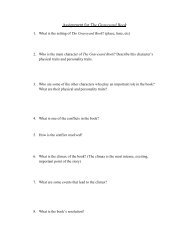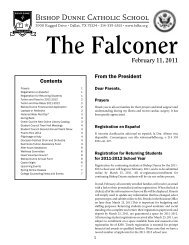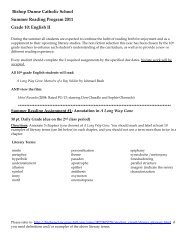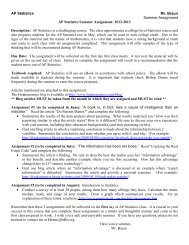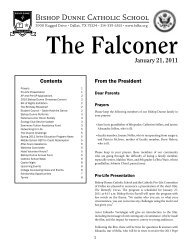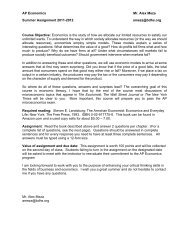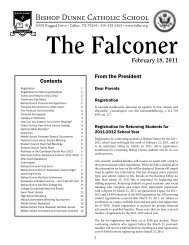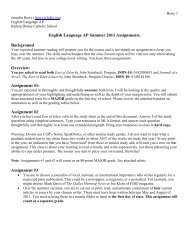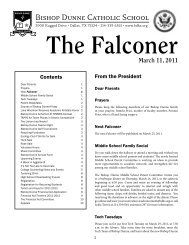AP Spanish Literature for the 2012-2013 school year! You obv
AP Spanish Literature for the 2012-2013 school year! You obv
AP Spanish Literature for the 2012-2013 school year! You obv
You also want an ePaper? Increase the reach of your titles
YUMPU automatically turns print PDFs into web optimized ePapers that Google loves.
Dear Students:<br />
<strong>AP</strong> SPANISH LITERATURE<br />
SUMMER READING <strong>2012</strong><br />
Welcome to <strong>AP</strong> <strong>Spanish</strong> <strong>Literature</strong> <strong>for</strong> <strong>the</strong> <strong>2012</strong>-<strong>2013</strong> <strong>school</strong> <strong>year</strong>! <strong>You</strong> <strong>obv</strong>iously like a<br />
challenge, because you have selected a very demanding course!<br />
<strong>You</strong> will be reading <strong>the</strong> works of about 35 writers from Spain and Latin America. They<br />
are among <strong>the</strong> most outstanding authors in <strong>the</strong> <strong>Spanish</strong>-speaking world: playwrights,<br />
poets, essayists and novelists from <strong>the</strong> Middle Ages to <strong>the</strong> present. <strong>You</strong> will read and<br />
summarize one or more works of each writer, <strong>the</strong>n discuss <strong>the</strong> <strong>the</strong>mes and analyze how<br />
<strong>the</strong> writers artistry (choice of words, rhetorical devices, etc.) relates to <strong>the</strong> ideas,<br />
messages and feelings he or she wishes to convey to <strong>the</strong> reader. While <strong>the</strong> class will<br />
spend several days or weeks on certain authors and works, at o<strong>the</strong>r times you will be<br />
required to read and analyze a short story or poem every day. Of course, class will be<br />
conducted in <strong>Spanish</strong>, and all assignments and assessments will be in <strong>Spanish</strong>.<br />
<strong>You</strong> will do a great deal of writing:<br />
answering questions as to <strong>the</strong> content and <strong>for</strong>m of each poem, play and short story<br />
writing essays analyzing a poem, short story, play, <strong>the</strong>me or character<br />
writing essays comparing aspects of two or more literary works or authors<br />
writing essays commenting on a literary critics analysis of a writers work<br />
Much of <strong>the</strong> writing will be assigned as homework, but <strong>the</strong> critical essays will be written<br />
in class, sometimes as part of a test.<br />
Attached is a list of <strong>the</strong> writers and works you will be required to study in order to<br />
prepare <strong>for</strong> <strong>the</strong> <strong>AP</strong> <strong>Spanish</strong> <strong>Literature</strong> exam in May of <strong>2013</strong>. As you can see, it is very<br />
extensive. In order to get a head start on <strong>the</strong> coursework, you are receiving this packet of<br />
summer reading, which includes several 20th Century short stories from <strong>the</strong> list. Each is a<br />
masterpiece in itself, and <strong>the</strong> language is modern, so hopefully you will enjoy reading<br />
<strong>the</strong>m and not find <strong>the</strong>m too difficult. For each story, <strong>the</strong>re are comprehension questions<br />
and some analysis and interpretation activities. When you return to <strong>school</strong> in August, you<br />
will discuss each story, and <strong>the</strong>n be tested on your understanding of <strong>the</strong> story and <strong>the</strong><br />
narrative style of each author.<br />
The packet contains questions and activities <strong>for</strong> each story that you need to complete.<br />
All of <strong>the</strong>se stories are available online.<br />
Email me if you have any questions:<br />
ameza@bdhs.org<br />
Mr. Alex Meza
All work is due on <strong>the</strong> first day of class in August. Please use WORD and spellcheck.<br />
Write in complete sentences (En español).<br />
Emilia Pardo Bazan: Las medias rojas<br />
http://www.ciudadseva.com/textos/cuentos/esp/pardo/tierra.htm<br />
1. El cuento es muy triste, pero la tristeza que sentimos ¿surge de los hechos o del<br />
punto de vista del narrador ¿Quién narra el cuento ¿Es un narrador objetivo o<br />
subjetivo<br />
2. : El color rojo y sus matices dorados, amarillos, anaranjadas, etc. como los que se<br />
dan en una lumbre, <strong>for</strong>man una isotopía en este cuento. Haz la isotopía de la gama<br />
roja. ¿Es una isotopía lineal o tiene muchas variantes O sea, ¿los signos de rojo<br />
todos tienen el mismo significante o varían Explica.<br />
3. En los primeros dos párrafos tenemos una escena costumbrista de padre e hija.<br />
¿Qué hace cada uno ¿Qué nos dice este detalle de las costumbres españolas de<br />
esa época ¿Y del papel de la mujer<br />
4. Ildara le prepara la cena al padre: ¿se la prepara con mucho cariño y esmero (=<br />
care) ¿Qué nos indica este código<br />
5. Ya que la voz narrativa no nos conduce a tomar una postura ante los hechos que<br />
ocurren, el lector no tiene más remedio que hacerse algunas preguntas y llegar a<br />
su propia conclusión. ¿Es Ildara una joven presuntuosa (o egoísta o creída), como<br />
sugiere su padre Aunque es una sencilla campesina, sin embargo cuida mucho su<br />
aspecto físico. ¿Qué se puede decir del idealismo ignorante de Ildara, quien cree<br />
que en América “el oro rueda por las calles” ¿Crees que Ildara hace bien en<br />
abandonar a su viejo padre e irse a América ¿Se puede justificar de algún modo<br />
el acto violento del padre<br />
6. ¿Qué diría un crítico feminista de este relato (O sea, ¿cómo se pinta la realidad<br />
de la mujer)<br />
7. ¿Por qué lleva las medias rojas<br />
“El conde Lucanor”, cuento XXV “ De lo que aconteció a un mancebo que se casó con<br />
una mujer muy brava.”, Don Juan Manuel<br />
http://ariastotelesplatonico.blogspot.com/2009/11/ejemplo-xxxv-de-el-condelucanor.html<br />
1. Esta obra presenta “un cuento dentro de un cuento”. Haz un breve<br />
Resumen de los dos cuentos, identificando a sus personajes.<br />
2. Explica la moraleja del cuento.<br />
"Un día de éstos”, Gabriel García Márquez<br />
http://www.ciudadseva.com/textos/cuentos/esp/ggm/dia.htm<br />
1. Describe los complejos sentimientos que afligen al dentista de este cuento.<br />
Justifica tu descripción con citas textuales y comenta la <strong>for</strong>ma en que el autor nos<br />
retrata éstos sentimientos.<br />
2. Explica la declaración del dentista "Con esto nos paga veinte muertos”.



